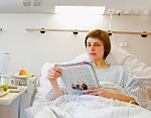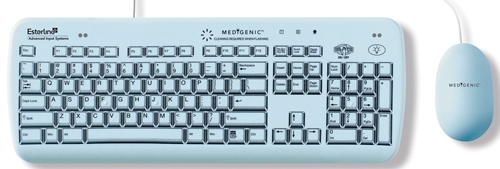THE Health and Social Care Act 2008 Code of Practice on the prevention and control of infections and related guidance, which came into force on 1 April this year, requires that healthcare facilities ‘provide and maintain a clean and appropriate environment in managed premises that facilitates the prevention and control of infections’.
The code defines the environment as ‘the totality of a service user’s surroundings when in care premises or transported in a vehicle. This includes the fabric of the building, related fixtures and fittings, and services such as air and water supplies’.
The key to achieving this, according to Matt Richardson, infection control lead at Portsmouth Hospitals NHS Trust, is to have surfaces that are easy to clean with no nooks and crannies that are difficult to get to. That means washable floors, sealed window cases and fixtures and fittings that are recessed into the wall with smooth edges and no hidden crevices in which dirt can hide.
Rob Emery, healthcare lighting specialist at Philips, adds: “Lighting can play an important role in any healthcare environment, whether this be functional lighting to enable staff to carry out their tasks comfortably, or to improve the patient experience by creating a more relaxing environment. However, any application must also comply with infection control standards.

“Within a number or areas, including operating theatres, sealed luminaries are required to meet these standards. Throughout the general areas of a hospital, LED solutions such as LuxSpace and PowerBalance, which replace downlighters and modular 600x600 fittings, reduce the build-up of dust within the fitting as there are no traditional lamps or louvers for it to adhere to.”
Furniture also needs to be easy to clean, and this means smooth surfaces, such as vinyl, rather than fabric coverings on chairs and sofas - a policy adhered to by the Portsmouth trust. Similarly, bedside tables and cupboards should have smooth surfaces and moulded edges for easy cleaning, says Richardson.
Healthcare furniture supplier Renray Healthcare’s Enterprise lockers, for example, are made from a single-piece of plastic with moulded drawers and smooth surfaces so there are no joins in which dirt can hide and they can be easily wiped clean. Its chairs and sofas are made from a range of antimicrobial fabrics, including antimicrobial vinyl and antimicrobial impervious fabric. In addition, the wooden arms of all chairs are hygienilac coated to prevent the growth of bacteria.
The emphasis across the range is on smooth easy-to-clean surfaces and highlighting the importance of maintaining a clean environment.
In many areas at Portsmouth Hospital, hands-free taps have also been fitted and sensors enable lights to be turned on and doors to open through the detection of hand movement, rather than by direct touch.

The trust also uses Medigenic keyboards which have been approved by the Rapid Review Panel (RRP) to help boost its infection control rates. The RRP describes the Medigenic as ‘a smart infection-control keyboard that helps monitor its own cleaning status to safeguard both patients and staff. The Medigenic keyboard’s flat design quickly wipes clean with hospital-grade disinfectants. Users can touch-type easily due to the excellent tactile key response’.
Disposable curtains are also an option in the fight against infection. For example, Opal Disposables cubicle curtains have a Biocote coating and fit on 90% of curtain tracks. The date they are due to be changed can be marked on the label – and they can then be recycled.
Lighting can play an important role in any healthcare environment, whether this be functional lighting to enable staff to carry out their tasks comfortably, or to improve the patient experience by creating a more relaxing environment. However, any application must also comply with infection control standards
Where non-disposable curtains are used, they need to be made of sturdy enough material to withstand the washing and finishing temperatures required to effectively clean them – and sufficient sets purchased to allow for laundering.
In another move to work to reduce the incidence of infection, the Department of Health and the Design Council have collaborated together on the Design Bugs Out programme to find ways that product design can contribute to the ongoing reduction of infections in the NHS. As a result, a number of innovative products have been developed, including:
- A patient bedside storage system constructed out of hard-wearing, mouldable plastic that is easy to wipe clean and, because it is fully mobile, staff can easily move it to clean the bedside area
- A patient chair with interchangeable cushions and fabric cases, waterproof padding and smooth surfaces
- A bedside cabinet with removable drawers and backless design to facilitate cleaning
- An RFID lock activated by a chip which can be housed in the patient’s ID bracelet
- The KwickScreen MRSA isolation facility screen
- Easy-to-clean curtain clips
NHS Supply Chain was brought in on the project in early 2010 to help bring the products to market. A spokesman said: “We were pleased to be able to support this initiative which matches our own strategy to source best products to help the NHS reduce infection rates.”
The products were tested in eight showcase hospitals and a summary report with feedback on their efficacy is due out shortly.
To monitor its infection control testing and maintain an ongoing watch on infection control rates in the trust, Portsmouth started using the VitalPAC infection control software system. By providing early warning of potential outbreaks, Richardson says, the trust has been able to prevent cross-infection.
As a result of this, and its other infection prevention measures, productivity has increased, the trust has been able to treat 20% more patients, and the incidence of norovirus has reduced from 20 to none.
References
1. Health Protection Agency, Quarterly Epidemiological Commentary: Mandatory MRSA bacteraemia & Clostridium difficile infection (up to October - December 2010), 17 March 2011.

